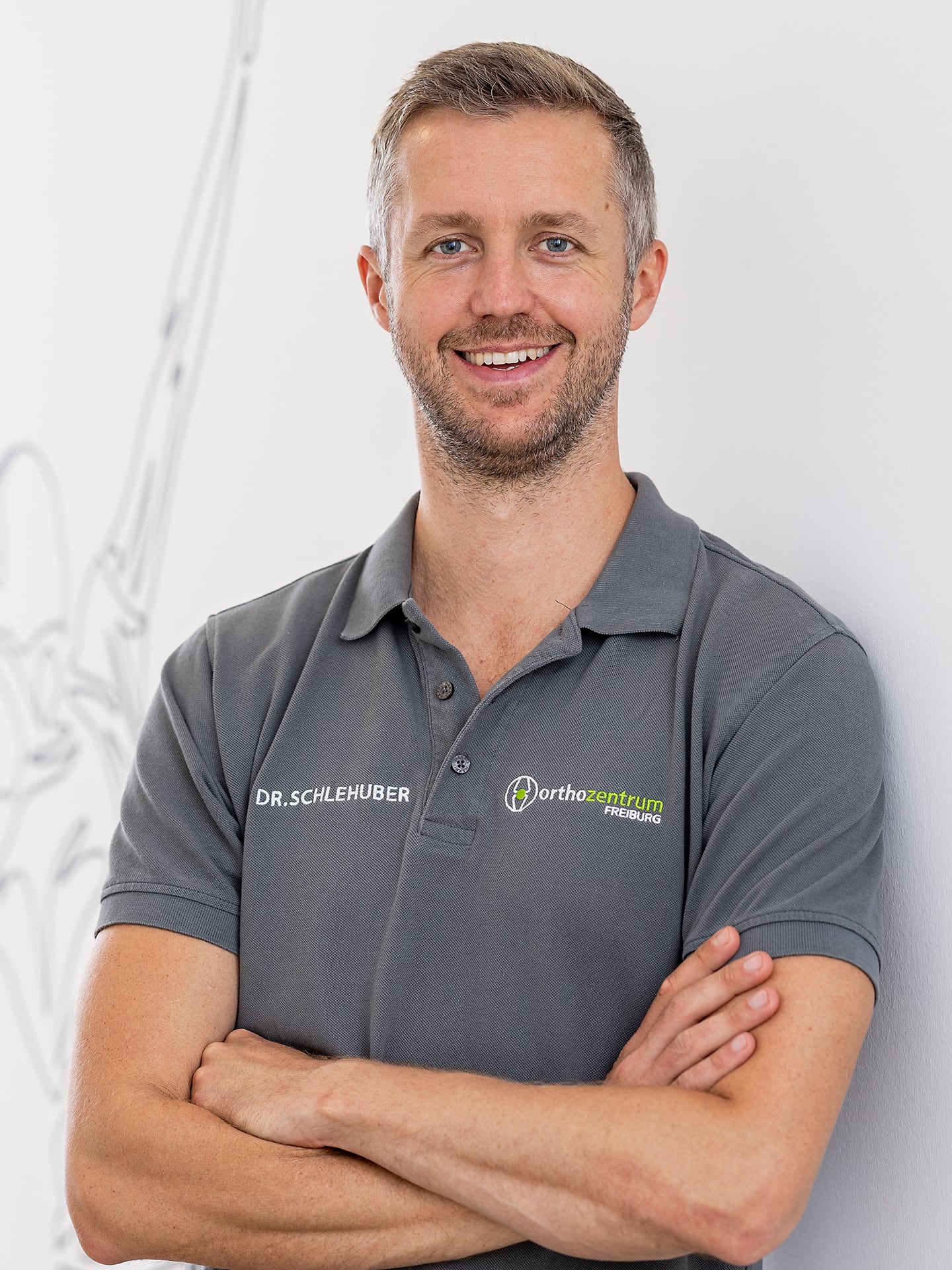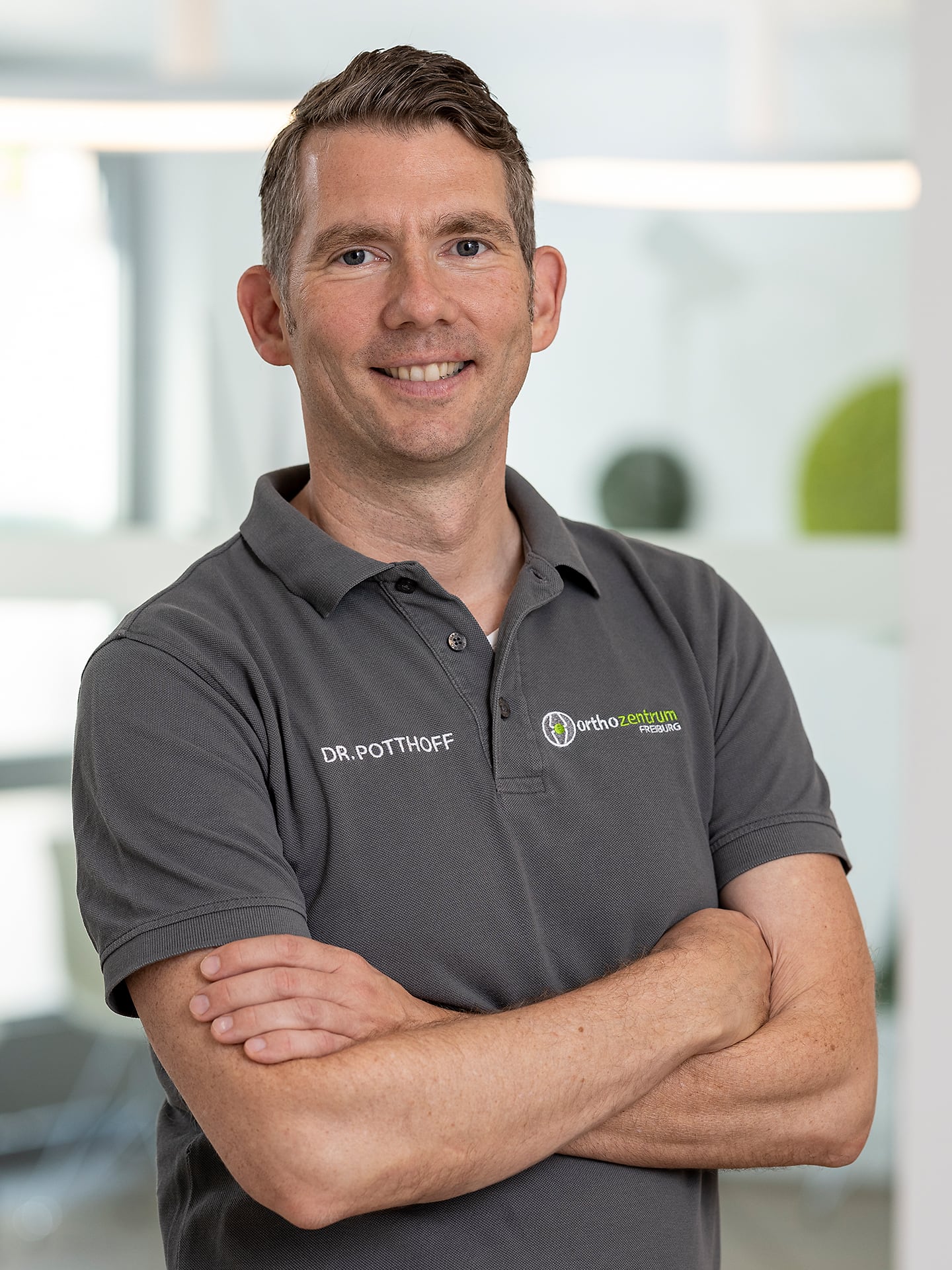Areas of application
Die Endoprothetik beschreibt den künstlichen Ersatz eines geschädigten Gelenks. Ein chirurgischer Eingriff dieser Art soll durch Schmerzreduktion und Verbesserung der Beweglichkeit zur Wiederherstellung der Lebensqualität der Patienten und Patientinnen beitragen.
The knee specialists of the Orthozentrum Freiburg Dr. med. Tarek Schlehuber and Dr. med. Dan Potthoff perform endoprosthetic knee and hip operations at the Lorettokrankenhaus Freiburg.
Causes for knee joint replacement may include:
- Knee joint arthrosis (gonarthrosis)
- Misalignments
- Injuries
- Inflammation of the joints (arthritis)
Several diseases can cause severe damage to the knee joint, making joint replacement necessary. These diseases can be accidental, inflammatory or age-related.
By far the most common cause is knee joint arthrosis (gonarthrosis), in which signs of wear and tear lead to degradation of the joint cartilage. If conservative therapy measures fail and there is a high level of suffering in everyday life, surgical replacement of the knee joint should be considered.
Prosthetic models
A distinction can be made between two different forms of prostheses: Hemi-endoprostheses (HEP) and total endoprostheses (TEP). Hemi-endoprostheses replace part of the knee joint, while total endoprostheses replace the entire knee joint. With the help of an X-ray, a physical examination and a detailed discussion, you and your treating surgeon can select the appropriate prosthesis model.

X-ray image after Oxford sled prosthesis
X-ray image after Oxford sled prosthesis
Hemislide prostheses
Hemi-slide prostheses (unicondylar sled prosthesis) are used when the wear on the knee joint is only unilateral and all the ligaments are still intact, for example in the case of unilateral wear of the knee joint cartilage in the context of bow legs. Specifically, the joint surface at the bottom of the thigh is replaced by a prosthesis, either the inner or the outer part of the knee joint. On the tibia, only the joint surface opposite the prosthesis is replaced.

X-ray image after total knee arthroplasty
X-ray image after total knee arthroplasty
Total endoprostheses
Total endoprostheses are used in the advanced stage of cartilage destruction. They are made up of three different parts: the femoral part, the tibial part and a sliding surface between these parts. The femoral part and the tibial part are made of robust metal alloys, and the sliding surface between them is made of special plastic.
Operation procedure
Zuerst wird über dem Knie ein gerader Schnitt mit dem Skalpell durchgeführt und das Kniegelenk wird anschließend freigelegt. Die geschädigten Gelenkflächen des Oberschenkelknochens (Femur) und des Schienbeins (Tibia) werden mithilfe einer Knochensäge abgetragen. Danach wird die richtige Größe der Prothese bestimmt und das neue Kniegelenk wird implantiert. Abschließend muss die Wunde noch vernäht werden. Während der Operation erhält der/die Patient/-in über die Vene Antibiotika, um Infektionen der Wunde zu vermeiden.
Our knee specialists will discuss the procedure, anesthesia and any questions that may arise in detail with you before the surgery.
Everything at a glance:
- Operation time: 60-120 min
- Anesthesia: general anesthesia, spinal anesthesia
- Clinic stay: inpatient
- Fit for work: after approx. 6 weeks
- Return to sports (RTS): after approx. 3 months
Aftercare
Direkt nach der Operation erfolgt eine Röntgenuntersuchung, um den optimalen Sitz der Prothese zu überprüfen. Der/Die Patient/-in wird nach dem chirurgischen Eingriff noch einige Tage stationär überwacht (drei bis sieben Tage), um die Wundheilung zu überprüfen, etwaige Schmerzen zu lindern und unter der Anleitung eines Physiotherapeuten mit ersten Bewegungen zu beginnen.
Due to the reduced physical activity after surgery, thrombosis prophylaxis should be given for about 2 weeks to prevent blood clots. This involves injecting a medication into the lateral abdominal area.
In addition, a so-called ossification prophylaxis is performed. Ossification describes the ossification of soft tissues or muscle tissue, which occurs frequently after prosthesis implantation. For this purpose, a drug from the group of non-steroidal anti-inflammatory drugs (NSAIDs) is administered over 2 weeks.
In the course, rehabilitation should be performed to build up the muscles and mobilize the joint, followed by physiotherapy.


